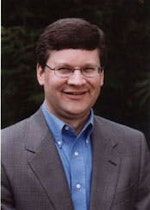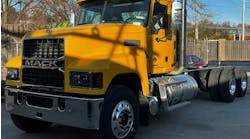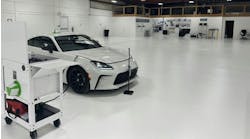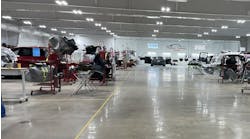Collision repairers should be prepared for new regulations, legislation and standard developments in 2011
Numbers don't lie
As in sports, momentum can make the difference between winning and losing, and if there's any momentum coming out of 2010, it's mostly working in the collision repair industry's favor.
Late in 2010, CCC Information Services was expecting the percentage of vehicles to be declared total losses to dip slightly from the previous year. The industry has had something to do with that because it has used more recycled, remanufactured and non-OEM parts. More than 74 percent of the money spent on parts in 2007 were for OEM parts, according to Mitchell International. That percentage declined to 68 percent in 2010, with the other categories showing gains. Recycled or used parts accounted for 13.4 percent of parts dollars last year, an increase from 10.4 percent in 2007.
Repairers are doing more repairing and less replacing. Audatex reports 79.2 percent of parts were replaced in early 2008, compared to 20.8 percent in the repair category. In the third quarter of 2010, the repair percentage climbed to 23.6 percent with a corresponding decline in replacement.Another trend that should have collision repairers feeling optimistic is Americans are driving again. Vehicle miles traveled, the measure of motorist activity, was rebounding in the second half of 2010, reaching a higher level in August than any month in 2007. This past fall, the 12-month average was less than 2 percent below the prerecession record-high. Most analysts expect that upward trend to continue, even if only modestly.
EPA enforcement
With new training and equipment requirements under the Environmental Protection Agency's (EPA) refinish regulation, the Automotive Service Association (ASA) says it will press the agency to begin enforcing the regulation by this spring.
"We have a good reg, and now we need strong enforcement around the country," ASA's Bob Redding said at a recent press conference.For information about the regulation visit the EPA's Collision Repair Campaign website at www.epa.gov/collisionrepair.
State legislation
A number of states will consider legislation that will impact collision repairers, following up on similar legislation introduced last year in some cases.
Shop associations in Iowa and Minnesota say they may take another run at legislation addressing the issue of shops in those states not being reimbursed for state sales tax paid on paint and materials purchases.
Last year, the Alliance of Automotive Service Providers (AASP) of Minnesota was successful helping craft language about the issue included in the state House and Senate tax bills, but it was opposed by the governor, who viewed it as a new tax, something he'd pledged not to allow, says Judell Anderson, executive director of AASP. The association argued it wasn't a new tax. Currently, shops pay tax on the wholesale cost of materials but can't collect it at the retail level because they charge for materials on a per-labor-hour rather than an itemized basis. But Anderson is confident the 2010 effort has set the groundwork for success regarding the issue.
Meanwhile, AASP of New Jersey is expected to continue pressing the state Motor Vehicle Commission and lawmakers to regulate companies conducting mobile repairs, such as those making lot repairs at dealerships. This past fall, Charlie Bryant of the AASP-NJ met with the new chief administrator of the commission to discuss the unfair playing field mobile repairers create.
AASP of Massachusetts is expected to continue its multiyear effort of trying to get an auto body labor rate bill enacted. Though passed by the Senate in that state this past year, the bill failed to move forward in the House. As drafted, the bill would create an advisory commission to determine what the average labor rate is nationally and adjust it for Massachusetts based on cost-of-living and other factors. Shops would receive that rate, or a percentage of it, based on their designation as an A or B shop.Efforts could continue in Ohio to enact a bill introduced into that state's legislature last year that would prohibit insurers from suggesting a collision repair shop unless asked by the insured or claimant for a recommendation.
More states likely will see airbag legislation introduced based on a model for states that was approved in late 2009 by a committee of the National Conference of Insurance Legislators (NCOIL). Such legislation was introduced in at least five states last year. Enacted in Rhode Island, the law requires shops to maintain detailed records of airbag replacements they make.But because of concern expressed by collision repairer associations that the legislation could be seen as sanctioning the use of salvage airbags, the NCOIL model was amended to require that if a salvage airbag is installed, a permanent sticker must be placed on the dashboard indicating that type of part was used. The Rhode Island law didn't include this requirement, only that the use of the salvage airbag be disclosed to the vehicle owner. Similar legislation – with or without the sticker requirement – likely will come before lawmakers in various states.
NCOIL considerations
The NCOIL committee expects to continue work on two other collision-related model bills this year. If approved, they could, like the airbag model, serve as the basis for legislation introduced into state legislatures.
One, related to non-OEM parts, has come before the NCOIL committee in various forms for more than a decade, but insurers, automakers and repairers continue to find one or more elements of the proposal unacceptable. Nevertheless, the committee is expected to make a final vote on the latest version when it meets this March in Washington, D.C. Although the committee rejected a model bill related to steering of consumers by insurers this past fall, the issue is expected to be raised at NCOIL again this year.
"We want to promote a system that lets consumers choose the repair shops they want, rather than respond to insurer demands or pressure," said Sen. Ruth Teichman of Kansas, who chaired the NCOIL committee last year, following last fall's meeting.
Various elements of the antisteering model introduced last year faced opposition from repairer or insurer groups. ASA, for example, said the bill set no criteria for the training or equipment a shop should have to be recommended by an insurer, thus encouraging a system seeking the lowest common denominator within the marketplace, punishing those shops with higher standards. ASA told the committee the model legislation didn't adequately ensure there would be no interference with a consumer's shop choice once it had been made. Teichman believes language can be written to ensure consumer choice. Then the committee could revisit the issue.
Developing standards
Another multiyear effort that should continue to make headlines this year is the development of formalized industry standards for collision shops and repairs. Jeff Patti, chairman of the Collision Industry Conference (CIC) Repair Standards committee, which works on standards development, believes there's a clear need for such formal, industry-recognized repair standards.
"There's no measurement out there currently to measure a repair by," Patti said. "There's no baseline."
Patti points to the standards program established in the United Kingdom as an example of what could be established in the United States. In the U.K., standards set guidelines for man, machine, methods and materials, and three levels of certification are available to allow for different types of shops (those doing only cosmetic repair, for example). Certified shops are allowed to use the Kitemark logo, which is an independent quality mark recognized by 80 percent of U.K. consumers. Three years into the program, about 770 shops have become accredited. That number is expected to double in the next two or three years to equal about the number of U.K. shops that are involved in insurer direct repair programs.
The discussion of standards often includes debates about how the process should be overseen and funded and who should be involved in the standards-setting process. Patti argues industry standards generally include input from all stakeholders, which, in the case of collision repair, would include shops, insurers and automakers.
But Aaron Schulenburg, executive director of the Society of Collision Repair Specialists (SCRS), has raised concerns about involvement in standards development by those who don't repair cars nor hold the final liability for those repairs.
"It's ultimately the repairer who would abide by the standards," Schulenburg says. "When you have stakeholders, there are special interests involved. There's a lot of skepticism about abiding by repair standards that are developed by other entities with vested interest in how they want us to act."
Despite such unresolved issues about standards, a group formed this past November as an off-shoot of the CIC committee hopes to hire a temporary project manager to take the work to date by the CIC committee and develop a plan, timeline and budget for completion of formalized standards, and for the creation or designation of an entity to oversee and implement adoption of the standards within the industry. It's clear the standards development process will be among the key issues for the collision industry.



